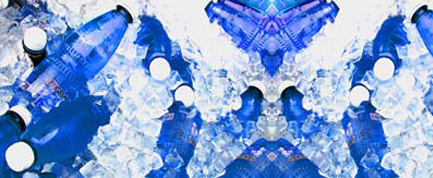Real-World Recycling Puts U.S. to Shame

The other day I was walking through a store that specializes in ethnic goods from around the world, and I picked up a magnificent serving tray from Zimbabwe. It was about two feet across, a spiral of tightly woven white material marked with bright spots of blue and orange.
“What’s this made of?” I asked the clerk, expecting him to name some exotic reeds, or maybe branches from a tree found only on the African savanna. “Plastic bags” was his answer, and even looking close, you couldn’t tell.
But once I knew, I could imagine the artist gathering up all those plastic bags that now dot the roadsides of Africa and devising a way to make something useful, and beautiful, out of someone else’s trash.
In Western culture, we think recycling is all about putting your newspapers and bottles in the right bins, and maybe using recycled paper in the printer or Xerox machine. But in other countries, ones that are not so awash in material goods, anything and everything has a second, third and maybe a fourth life.
In Bali, Indonesia, for example, a coke bottle is not just returned for deposit. Instead, all soda bottles are washed by hand at home and then refilled with all kinds of drinks from water to tea. These bottles also come in handy to transport gasoline to a stalled moped.
In most other countries, used car tires don’t just stack up. They are cut into pieces and crafted into flip flops, becoming sandals with “all weather” tread.
In East Africa, people also make good use out of discarded tins. I’ve seen bright yellow Penzoil cans cut and reformed into votive lamps and palm oil cans flattened and used for roofing material.
Get the world’s most fascinating discoveries delivered straight to your inbox.
Kids also take meat tins and beer cans and fashion them into various toys such as cars and boats. Along the roadside and in tourist camps, these kids scrounging for materials and with a little time and workmanship morph them into something just as good — and often more interesting — than a toy from a box.
But my favorite type of recycled good is the object of beauty.
I own a pair of Maasai earrings that I bought from a woman in Tanzania. They are flaps of leather eight inches long and two inches wide. The leather is covered with an intricate design of red, blue, and orange glass beads and set with several white shirt buttons. Hanging off the sides are arrowheads made of hammered metal from a can that probably held tuna, or peaches, or spam.
And only after hours of staring at these objects of incredible craftsmanship one day did I suddenly realize that the outline of each earring is made by one half of a zipper, presumably torn from a old pair of trousers left by the road by someone who apparently had no idea of their artistic value.
Although they are as beautiful as a pair of the finest Tiffany earrings, I only have the usual Western pin-sized pierced earring holes and my lobes simply can't accommodate two-inch wide flaps of leather.
And so this pair of earrings made of recycled goods hangs on my wall as a piece of fine art.
- Video: Who Pay's Most for Earth's Ills?
- Quiz: What's Your Environmental Footprint?
- Find a Recycling Center Near You
Meredith F. Small is an anthropologist at Cornell University. She is also the author of "Our Babies, Ourselves; How Biology and Culture Shape the Way We Parent" (link) and "The Culture of Our Discontent; Beyond the Medical Model of Mental Illness" (link).
 Live Science Plus
Live Science Plus





